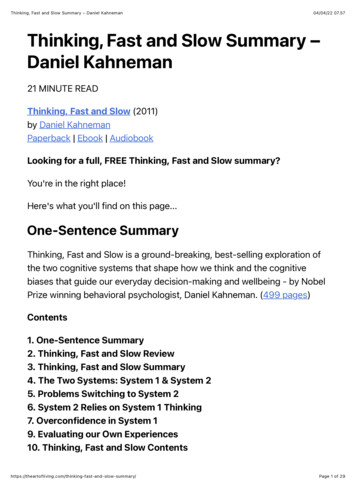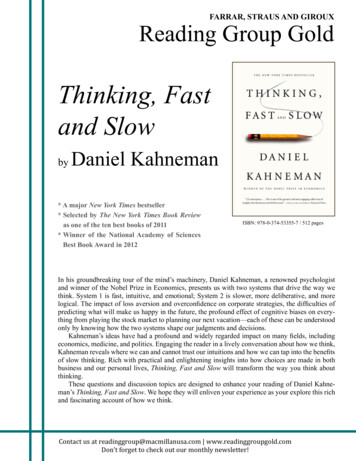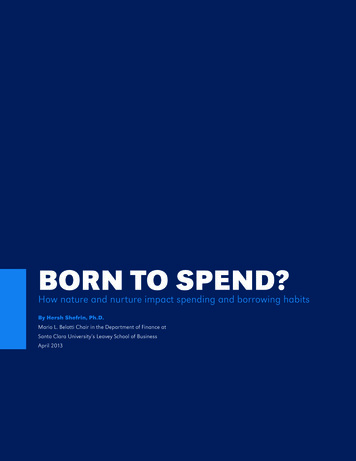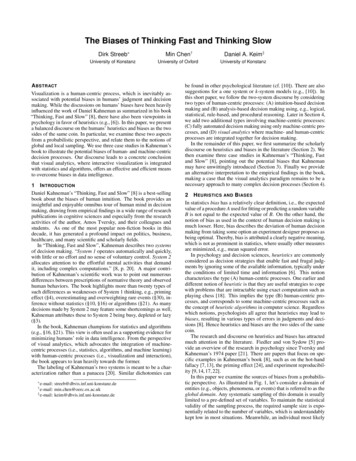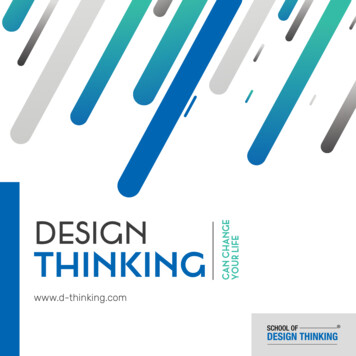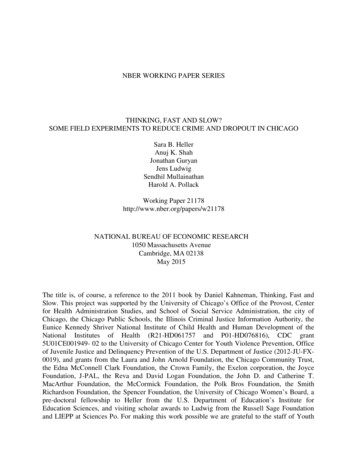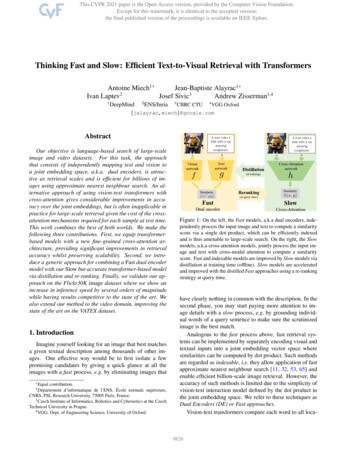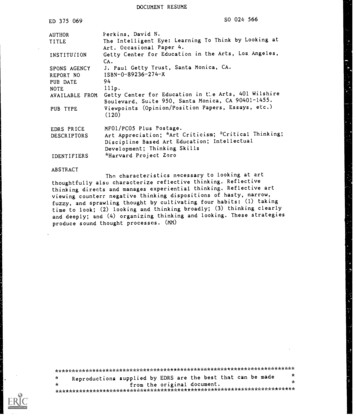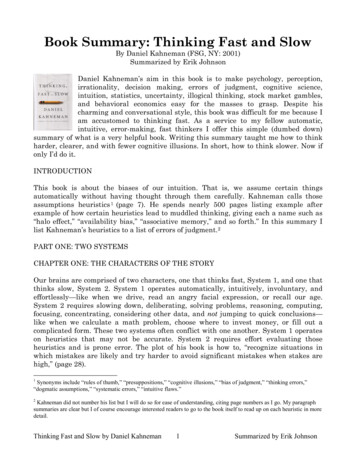
Transcription
Book Summary: Thinking Fast and SlowBy Daniel Kahneman (FSG, NY: 2001)Summarized by Erik JohnsonDaniel Kahneman’s aim in this book is to make psychology, perception,irrationality, decision making, errors of judgment, cognitive science,intuition, statistics, uncertainty, illogical thinking, stock market gambles,and behavioral economics easy for the masses to grasp. Despite hischarming and conversational style, this book was difficult for me because Iam accustomed to thinking fast. As a service to my fellow automatic,intuitive, error-making, fast thinkers I offer this simple (dumbed down)summary of what is a very helpful book. Writing this summary taught me how to thinkharder, clearer, and with fewer cognitive illusions. In short, how to think slower. Now ifonly I’d do it.INTRODUCTIONThis book is about the biases of our intuition. That is, we assume certain thingsautomatically without having thought through them carefully. Kahneman calls thoseassumptions heuristics 1 (page 7). He spends nearly 500 pages listing example afterexample of how certain heuristics lead to muddled thinking, giving each a name such as“halo effect,” “availability bias,” “associative memory,” and so forth.” In this summary Ilist Kahneman’s heuristics to a list of errors of judgment.2PART ONE: TWO SYSTEMSCHAPTER ONE: THE CHARACTERS OF THE STORYOur brains are comprised of two characters, one that thinks fast, System 1, and one thatthinks slow, System 2. System 1 operates automatically, intuitively, involuntary, andeffortlessly—like when we drive, read an angry facial expression, or recall our age.System 2 requires slowing down, deliberating, solving problems, reasoning, computing,focusing, concentrating, considering other data, and not jumping to quick conclusions—like when we calculate a math problem, choose where to invest money, or fill out acomplicated form. These two systems often conflict with one another. System 1 operateson heuristics that may not be accurate. System 2 requires effort evaluating thoseheuristics and is prone error. The plot of his book is how to, “recognize situations inwhich mistakes are likely and try harder to avoid significant mistakes when stakes arehigh,” (page 28).1Synonyms include “rules of thumb,” “presuppositions,” “cognitive illusions,” “bias of judgment,” “thinking errors,”“dogmatic assumptions,” “systematic errors,” “intuitive flaws.”2Kahneman did not number his list but I will do so for ease of understanding, citing page numbers as I go. My paragraphsummaries are clear but I of course encourage interested readers to go to the book itself to read up on each heuristic in moredetail.Thinking Fast and Slow by Daniel Kahneman1Summarized by Erik Johnson
CHAPTER TWO: ATTENTION AND EFFORTThinking slow affects our bodies (dilated pupils), attention (limited observation), andenergy (depleted resources). Because thinking slow takes work we are prone to think fast,the path of least resistance. “Laziness is built deep into our nature,” (page 35). We thinkfast to accomplish routine tasks and we need to think slow in order to managecomplicated tasks. Thinking fast says, “I need groceries.” Thinking slow says, “I will nottry to remember what to buy but write myself a shopping list.”CHAPTER THREE: THE LAZY CONTROLLERPeople on a leisurely stroll will stop walking when asked to complete a difficult mentaltask. Calculating while walking is an energy drain. This is why being interrupted whileconcentrating is frustrating, why we forget to eat when focused on an interesting project,why multi-tasking while driving is dangerous, and why resisting temptation is extrahard when we are stressed. Self control shrinks when we’re tired, hungry, or mentallyexhausted. Because of this reality we are prone to let System 1 take over intuitively andimpulsively. “Most people do not take the trouble to think through [a] problem,” (page 45).“Intelligence is not only the ability to reason; it is also the ability to find relevantmaterial in memory and to deploy attention when needed,” (page. 46). Accessing memorytakes effort but by not doing so we are prone to make mistakes in judgment.CHAPTER FOUR: THE ASSOCIATIVE MACHINEHeuristic #1: PRIMING. Conscious and subconscious exposure to an idea “primes” usto think about an associated idea. If we’ve been talking about food we’ll fill in the blankSO P with a U but if we’ve been talking about cleanliness we’ll fill in the blank SO Pwith an A. Things outside of our conscious awareness can influence how we think. Thesesubtle influences also affect behavior, “the ideomotor effect,” (page 53). People readingabout the elderly will unconsciously walk slower. And people who are asked to walkslower will more easily recognize words related to old age. People asked to smile findjokes funnier; people asked to frown find disturbing pictures more disturbing. It is true:if we behave in certain ways our thoughts and emotions will eventually catch up. We cannot only feel our way into behavior, we can behave our way into feelings. Potential forerror? We are not objective rational thinkers. Things influence our judgment, attitude,and behavior that we are not even aware of.CHAPTER FIVE: COGNITIVE EASEHeuristic #2: COGNITIVE EASE. Things that are easier to compute, more familiar,and easier to read seem more true than things that require hard thought, are novel, orare hard to see. “Predictable illusions inevitably occur if a judgment is based on theimpression of cognitive ease or strain,” (page 62). “How do you know that a statement istrue? If it is strongly linked by logic or association to other beliefs or preferences you hold,or comes from a source you trust and like, you will feel a sense of cognitive ease,” (pageThinking Fast and Slow by Daniel Kahneman2Summarized by Erik Johnson
64). Because things that are familiar seem more true teachers, advertisers, marketers,authoritarian tyrants, and even cult leaders repeat their message endlessly. Potential forerror? If we hear a lie often enough we tend to believe it.CHAPTER SIX: NORMS, SURPRISES, AND CAUSESHeuristic #3: COHERENT STORIES (ASSOCIATIVE COHERENCE). To makesense of the world we tell ourselves stories about what’s going on. We make associationsbetween events, circumstances, and regular occurrences. The more these events fit intoour stories the more normal they seem. Things that don’t occur as expected take us bysurprise. To fit those surprises into our world we tell ourselves new stories to make themfit. We say, “Everything happens for a purpose,” “God did it,” “That person acted out ofcharacter,” or “That was so weird it can’t be random chance.” Abnormalities, anomalies,and incongruities in daily living beg for coherent explanations. Often those explanationsinvolve 1) assuming intention, “It was meant to happen,” 2) causality, “They’re homelessbecause they’re lazy,” or 3) interpreting providence, “There’s a divine purpose ineverything.” “We are evidently ready from birth to have impressions of causality, whichdo not depend on reasoning about patterns of causation,” (page 76). “Your mind is readyand even eager to identify agents, assign them personality traits and specific intentions,and view their actions as expressing individual propensities,” (page 76). Potential forerror? We posit intention and agency where none exists, we confuse causality withcorrelation, and we make more out of coincidences than is statistically warranted.CHAPTER SEVEN: A MACHINE FOR JUMPING TO CONCLUSIONSHeuristic #4: CONFIRMATION BIAS. This is the tendency to search for and findconfirming evidence for a belief while overlooking counter examples. “Jumping toconclusions is efficient if the conclusions are likely to be correct and the costs of anoccasional mistake acceptable, and if the jump saves much time and effort. Jumping toconclusions is risky when the situation is unfamiliar, the stakes are high, and there is notime to collect more information,” (page 79). System 1 fills in ambiguity with automaticguesses and interpretations that fit our stories. It rarely considers other interpretations.When System 1 makes a mistake System 2 jumps in to slow us down and consideralternative explanations. “System 1 is gullible and biased to believe, System 2 is incharge of doubting and unbelieving, but System 2 is sometimes busy, and often lazy,”(page 81). Potential for error? We are prone to over-estimate the probability of unlikelyevents (irrational fears) and accept uncritically every suggestion (credulity).Heuristic #5: THE HALO EFFECT. “This is the tendency to like or dislike everythingabout a person—including things you have not observed,” (page 82). The warm emotionwe feel toward a person, place, or thing predisposes us to like everything about thatperson, place, or thing. Good first impressions tend to positively color later negativeimpressions and conversely, negative first impressions can negatively color later positiveimpressions. The first to speak their opinion in a meeting can “prime” others’ opinions. Alist of positive adjectives describing a person influences how we interpret negativeThinking Fast and Slow by Daniel Kahneman3Summarized by Erik Johnson
adjectives that come later in the list. Likewise, negative adjectives listed early colorslater positive adjectives. The problem with all these examples is that our intuitivejudgments are impulsive, not clearly thought through, or critically examined. To remindSystem 1 to stay objective, to resist jumping to conclusions, and to enlist the evaluativeskills of System 2, Kahneman coined the abbreviation, “WYSIATI,” what you see is allthere is. In other words, do not lean on information based on impressions or intuitions.Stay focused on the hard data before us. Combat over confidence by basing our beliefs noton subjective feelings but critical thinking. Increase clear thinking by giving doubt andambiguity its day in court.CHAPTER EIGHT: HOW JUDGMENTS HAPPENHeuristic #6: JUDGEMENT. System 1 relies on its intuition, the basic assessments ofwhat’s going on inside and outside the mind. It is prone to ignore “sum-like variables,”(page 93). We often fail to accurately calculate sums but rely instead on often unreliableintuitive averages. It is prone to “matching,” (page 94). We automatically andsubconsciously rate the relative merits of a thing by matching dissimilar traits. We areprone to evaluate a decision without distinguishing which variables are most important.This is called the “mental shotgun” approach (page 95). These basic assessments caneasily replace the hard work System 2 must do to make judgments.CHAPTER NINE: AN EASIER QUESTIONHeuristic #7: SUBSTITUTION. When confronted with a perplexing problem, question,or decision, we make life easier for ourselves by answering a substitute, simpler question.Instead of estimating the probability of a certain complex outcome we rely on an estimateof another, less complex outcome.Instead of grappling with the mind-bendingphilosophical question, “What is happiness?” we answer the easier question, “What is mymood right now?” (page 98). Even though highly anxious people activate System 2 often,obsessing and second guessing every decision, fear, or risk, it is surprising how oftenSystem 1 works just fine for them. Even chronic worriers function effortlessly in manyareas of life while System 1 is running in the background. They walk, eat, sleep, breath,make choices, make judgments, trust, and engage in enterprises without fear, worry, oranxiety. Why? They replace vexing problems with easier problems. Potential for error?We never get around to answering the harder question.Heuristic #8: AFFECT. Emotions influence judgment. “People let their likes anddislikes determine their beliefs about the world,” (page 103). Potential for error? We canlet our emotional preferences cloud our judgment and either under or over estimate risksand benefits.PART TWO: HEURISTICS AND BIASESCHAPTER TEN: THE LAW OF SMALL NUMBERSThinking Fast and Slow by Daniel Kahneman4Summarized by Erik Johnson
Heuristic #9: THE LAW OF SMALL NUMBERS. Our brains have a difficult timewith statistics. Small samples are more prone to extreme outcomes than large samples,but we tend to lend the outcomes of small samples more credence than statistics warrant.System 1 is impressed with the outcome of small samples but shouldn’t be. Smallsamples are not representative of large samples. Large samples are more precise. We errwhen we intuit rather than compute, (see page 113). Potential for error? We makedecisions on insufficient data.Heuristic #10: CONFIDENCE OVER DOUBT. System 1 suppresses ambiguity anddoubt by constructing coherent stories from mere scraps of data. System 2 is our innerskeptic, weighing those stories, doubting them, and suspending judgment. But becausedisbelief requires lots of work System 2 sometimes fails to do its job and allows us to slideinto certainty. We have a bias toward believing. Because our brains are patternrecognition devices we tend to attribute causality where none exists. Regularities occurat random. A coin flip of 50 heads in a row seems unnatural but if one were to flip a coinbillions and billions of times the odds are that 50 heads in a row would eventuallyhappen. “When we detect what appears to be a rule, we quickly reject the idea that theprocess is truly random,” (page 115). Attributing oddities to chance takes work. It’s easierto attribute them to some intelligent force in the universe. Kahneman advises, “acceptthe different outcomes were due to blind luck” (page 116). There are many facts in thisworld due to chance and do not lend themselves to explanations. Potential for error?Making connections where none exists.CHAPTER ELEVEN: ANCHORSHeuristic #11: THE ANCHORING EFFECT. This is the subconscious phenomenon ofmaking incorrect estimates due to previously heard quantities. If I say the number 10and ask you to estimate Gandhi’s age at death you’ll give a lower number than if I’d saidto you the number 65. People adjust the sound of their stereo volume according toprevious “anchors,” the parents’ anchor is low decibels, the teenager’s anchor is highdecibels. People feel 35 mph is fast if they’ve been driving 10 mph but slow if they justgot off the freeway doing 65 mph. Buying a house for 200k seems high if the askingprice was raised from 180k but low if the asking price was lowered from 220k. A 15minute wait to be served dinner in a restaurant seems long if the sign in the window says,“Dinner served in 10 minutes or less” but fast if the sign says, “There is a 30 minute waitbefore dinner will be served.” Potential for error? We are more suggestible than werealize.CHAPTER TWELVE: THE SCIENCE OF AVAILABIITYHeuristic #12: THE AVAILABILITY HEURISTIC. When asked to estimate numberslike the frequency of divorces in Hollywood, the number of dangerous plants, or thenumber of deaths by plane crash, the ease with which we retrieve an answer influencesthe size of our answer. We’re prone to give bigger answers to questions that are easier toretrieve. And answers are easier to retrieve when we have had an emotional personalThinking Fast and Slow by Daniel Kahneman5Summarized by Erik Johnson
experience. One who got mugged over-estimates the frequency of muggings, one exposedto news about school shootings over-estimates the number of gun crimes, and the onewho does chores at home over estimates the percentage of the housework they do. Whenboth parties assume they do 70% of the house work somebody is wrong because there’s nosuch thing as 140%! A person who has experienced a tragedy will over estimate thepotential for risk, danger, and a hostile universe. A person untroubled by suffering willunder-estimate pending danger. When a friend gets cancer we get a check up. Whennobody we know gets cancer we ignore the risk. Potential for error: under or overestimating the frequency of an event based on ease of retrieval rather than statisticalcalculation.CHAPTER THIRTEEN: AVAILABIITY, EMOTION, AND RISKHeuristic #13: AVAILABILITY CASCADES. When news stories pile up our statisticalsenses get warped. A recent plane crash makes us think air travel is more dangerousthan car travel. The more we fear air travel the more eager news reporters are tosensationalize plane crashes. A negative feedback loop is set in motion, a cascade of fear.“The emotional tail wags the rational dog,” (page 140). Potential for error? Over reactingto a minor problem simply because we hear a disproportionate number of negative newsstories than positive ones.CHAPTER FOURTEEN: TOM W’S SPECIALTYHeuristic #14: REPRESENTATIVENESS. Similar to profiling or stereotyping,“representativeness” is the intuitive leap to make judgments based on how similarsomething is to something we like without taking into consideration other factors:probability (likelihood), statistics (base rate), or sampling sizes. Baseball scouts used torecruit players based on how close their appearance resembled other good players. Onceplayers were recruited based on actual statistics the level of gamesmanship improved.Just because we like the design of a book cover doesn’t mean we’ll like the contents. Youcan’t judge a book by its cover. A start-up restaurant has a low chance of survivalregardless of how much you like their food. Many well run companies keep their facilitiesneat and tidy but a well kept lawn is no guarantee that the occupants inside areorganized. To discipline our lazy intuition we must make judgments based on probabilityand base rates, and question our analysis of the evidence used to come up with ourassumption in the first place. “Think like a statistician,” (page 152). Potential for error:Evaluating a person, place, or thing on how much it resembles something else withouttaking into account other salient factors.CHATPER FIFTEEN: LINDA: LESS IS MOREHeuristic #15: THE CONJUNCTION FALLACY (violating the logic of probability).After hearing priming details about a made up person (Linda), people chose a plausiblestory over a probable story. Logically, it is more likely that a person will have onecharacteristic than two characteristics. That is, after reading a priming description ofThinking Fast and Slow by Daniel Kahneman6Summarized by Erik Johnson
Linda respondents were more likely to give her two characteristics, which is statisticallyimprobable. It is more likely Linda would be a bank teller (one characteristic) than abank teller who is a feminist (two characteristics). “The notions of coherence, plausibility,and probability are easily confused by the unwary,” (page 159). The more details we addto a description, forecast, or judgment the less likely they are to be probable. Why? Stage1 thinking overlooks logic in favor of a plausible story. Potential for error: committing alogical fallacy, when our intuition favors what is plausible but improbable over what isimplausible and probable.CHAPTER SIXTEEN: CAUSES TRUMP STATISTICSHeuristic #16: OVERLOOKING STATISTICS. When given purely statistical data wegenerally make accurate inferences. But when given statistical data and an individualstory that explains things we tend to go with the story rather than statistics. We favorstories with explanatory power over mere data. Potential for error: stereotyping, profiling,and making general inferences from particular cases rather than making particularinferences from general cases.CHAPTER SEVENTEEN: REGRESSION TO THE MEANHeuristic #17: OVERLOOKING LUCK. Most people love to attach causalinterpretations to the fluctuations of random processes. “It is a mathematically inevitableconsequence of the fact that luck played a role in the outcome .Not a very satisfactorytheory—we would all prefer a causal account—but that is all there is,” (page 179). Whenwe remove causal stories and consider mere statistics we’ll observe regularities, what iscalled the regression to the mean. Those statistical regularities—regression to themean—are explanations (“things tend to even out”) but not causes (“that athlete had abad day but is now ‘hot’). “Our mind is strongly biased toward causal explanations anddoes not deal well with ‘mere statistics,’” (page 182). Potential for error: seeing causesthat don’t exist.CHAPTER EIGHTEEN: TAMING INTUITIVE PREDICTIONSHeuristic #18: INTUITIVE PREDICTIONS. Conclusions we draw with strongintuition (System 1) feed overconfidence. Just because a thing “feels right” (intuitive)does not make it right. We need System 2 to slow down and examine our intuition,estimate baselines, consider regression to the mean, evaluate the quality of evidence, andso forth. “Extreme predictions and a willingness to predict rare events from weakevidence are both manifestations of System 1. It is natural for the associative machineryto match the extremeness of predictions to the perceived extremeness on which it isbased—this is how substitution works,” (page 194). Potential for error: unwarrantedconfidence when we are in fact in error.Thinking Fast and Slow by Daniel Kahneman7Summarized by Erik Johnson
PART THREE: OVERCONFIDENCECHAPTER NINETEEN: THE ILLUSION OF UNDERSTANDINGHeuristic #19: THE NARRATIVE FALLACY. In our continuous attempt to makesense of the world we often create flawed explanatory stories of the past that shape ourviews of the world and expectations of the future. We assign larger roles to talent,stupidity, and intentions than to luck. “Our comforting conviction that the world makessense rests on a secure foundation: our almost unlimited ability to ignore our ignorance,”(page 201). This is most evident when we hear, “I knew that was going to happen!” Whichleads to Heuristic #20: THE HINDSIGHT ILLUSION. We think we understand the past,which implies the future should be knowable, but in fact we understand the past lessthan we believe we do. Our intuitions and premonitions feel more true after the fact.Once an event takes place we forget what we believed prior to that event, before wechanged our minds. Prior to 2008 financial pundits predicted a stock market crash butthey did not know it. Knowing means showing something to be true. Prior to 2008 no onecould show that a crash was true because it hadn’t happened yet. But after it happenedtheir hunches were retooled and become proofs. “The tendency to revise the history ofone’s beliefs in light of what actually happened produces a robust cognitive illusion,”(page 203). Potential for error: “We are prone to blame decision makers for good decisionsthat worked out badly and to give them too little credit for successful moves that appearobvious only after the fact. When the outcomes are bad, the clients often blame theiragents for not seeing the handwriting on the wall—forgetting that it was written ininvisible ink that became legible only afterward. Actions that seemed prudent inforesight can look irresponsibly negligent in hindsight,” (page 203).CHAPTER TWENTY: THE ILLUSION OF VALIDITYHeuristic #21: THE ILLUSION OF VALIDITY. We sometimes confidently believe ouropinions, predictions, and points of view are valid when confidence is unwarranted. Someeven cling with confidence to ideas in the face of counter evidence. “Subjective confidencein a judgment is not a reasoned evaluation of the probability that this judgment is correct.Confidence is a feeling, which reflects the coherence of the information and the cognitiveease of processing it” (page 212). Factors that contribute to overconfidence: being dazzledby one’s own brilliance, affiliating with like-minded peers, and over valuing our trackrecord of wins and ignoring our losses. Potential for error: Basing the validity of ajudgment on the subjective experience of confidence rather than objective facts.Confidence is no measure of accuracy.CHAPTER TWENTY-ONE: INTUITIONS VS. FORMULASHeuristic #22: IGNORING ALGORITHMS. We overlook statistical information andfavor our gut feelings. Not good! Forecasting, predicting the future of stocks, diseases, carThinking Fast and Slow by Daniel Kahneman8Summarized by Erik Johnson
accidents, and weather should not be influenced by intuition but they often are. Andintuition is often wrong. We do well to consult check lists, statistics, and numericalrecords and not rely on subjective feelings, hunches, or intuition. Potential for error:“relying on intuitive judgments for important decisions if an algorithm is available thatwill make fewer mistakes,” (page 229).CHAPTER TWENTY-TWO: EXPERT INTUITION: WHEN CAN YOU TRUST IT?Intuition means knowing something without knowing how we know it. Kahneman’sunderstanding is that intuition is really a matter of recognition, being so familiar withsomething we arrive at judgments quickly. Chess players “see” the chess board, firefighters “know” when a building is about to collapse, art dealers “identify” marks offorgeries, parents have a “sixth sense” when their kids are in danger, readers “read”letters and words quickly, and friends “are familiar” with their friends from a distance.Kids become experts at video games, motorists become expert drivers, and chefs becomeintuitive cooks. How? Recognition—either over long periods of exposure, or quickly in ahighly emotional event (accidents). Intuition is immediate pattern recognition, not magic.Heuristic #23: TRUSTING EXPERT INTUITION. “We are confident when the storywe tell ourselves comes easily to mind, with no contradiction and no competing scenario.But ease and coherence do not guarantee that a belief held with confidence is true. Theassociative machine is set to suppress doubt and to evoke ideas and information that arecompatible with the currently dominant story,” (page 239). Kahneman is skeptical ofexperts because they often overlook what they do not know. Kahneman trusts expertswhen two conditions are met: the expert is in an environment that is sufficiently regularto be predictable and the expert has learned these regularities through prolongedpractice. Potential for error: being mislead by “experts.”CHAPTER TWENTY-THREE: THE OUTSIDE VIEWHeuristic #24: THE PLANNING FALACY means taking on a risky project—litigation,war, opening a restaurant—confident of the best case scenario without seriouslyconsidering the worst case scenario. If we consult others who’ve engaged in similarprojects we’ll get the outside view. Failure to do this increases the potential for failure.Cost overruns, missed deadlines, loss of interest, waning urgency all result from poorplanning. Potential for error: “making decisions based on delusional optimism ratherthan on a rational weight of gains, losses, and probabilities,” (page 252). In other words,poorly planned grandiose projects will eventually fail.CHAPTER TWENTY-FOUR: THE ENGINE OF CAPITALISMHeuristic #25: THE OPTIMISTIC BIAS. We are prone to neglect facts, others’ failures,and what we don’t know in favor of what we know and how skilled we are. We believe theoutcome of our achievements lies entirely in our own hands while neglecting the luckfactor. We don’t appreciate the uncertainty of our environment. We suffer from theThinking Fast and Slow by Daniel Kahneman9Summarized by Erik Johnson
illusion of control and neglect to look at the competition (in business start-ups forexample). “Experts who acknowledge the full extent of their ignorance may expect to bereplaced by more confident competitors, who are better able to gain the trust of clients,”(page 263). Being unsure is a sign of weakness so we turn to confident experts who maybe wrong. Potential for error: unwarranted optimism which doesn’t calculate the oddsand therefore could be risky.PART FOUR: CHOICESCHAPTER TWENTY-FIVE: BERNOULLI’S ERRORSHeuristic #26: OMITTING SUBJECTIVITY. We often think an object has onlyintrinsic objective value. A million dollars is worth a million dollars, right? Wrong.Magically making a poor person’s portfolio worth a million dollars would be fabulous!Magically making a billionaire’s portfolio a worth a million dollars would be agony! Onegained, the other lost. Economists have erred by failing to consider a person’spsychological state regarding value, risk, anxiety, or happiness. 18th century economistBernoulli thought money had utility (fixed worth) but he failed to consider a person’sreference point. Potential for error: Making decisions on pure logic without consideringpsychological states.Heuristic #27: THEORY-INDUCED BLINDNESS. “Once you have accepted a theoryand used it as a tool in your thinking, it is extraordinarily difficult to notice its flaws. Ifyou come upon an observation that does not seem to fit the model, you assume that theremust be a perfectly good explanation that you are somehow missing,” (page 277). Whenthe blinders fall off the previously believed error seems absurd and the realbreakthrough occurs when you can’t remember why you didn’t see the obvious. Potentialfor error: Clinging to old paradigms that have outlived their validity.CHAPTER TWENTY-SIX: PROSPECT THEORYKahneman’s claim to fame is Prospect Theory (for which he won the Nobel prize ineconomics). Economists used to believe that the value of money was the sole determinantin explaining why people buy, spend, and gamble the way they do. Prospect Theorychanged that by explaining three things: 1) the value of money is less important then thesubjective experience of changes in one’s wealth. In other words, the loss or gain of 500is psychologically positive or negative depending on a reference point, how much moneyone already has. 2) We experience diminished sensitivity to changes in wealth: losing 100 hurts more if you start with 200 than if you start with 1000. And 3) we are loatheto lose money!Heuristic #28: LOSS AVERSION. “You just like winning and dislike losing—and youalmost certainly dislike losing more than you like winning,” (page 281). System 1thinking compares the psychological benefit of gain with the psychological cost of lossThinking Fast and Slow by Daniel Kahneman10Summarized by Erik Johnson
and the fear of loss usually wins. Potential for error: passing
Thinking slow affects our bodies (dilated pupils), attention (limited observation), and energy (depleted resources). Because thinking slow takes work we are prone to think fast, the path of least resistance. "Laziness is built deep into our nature," (page 35). We think fast to accomplish routine tasks and we need to think slow in order to .
